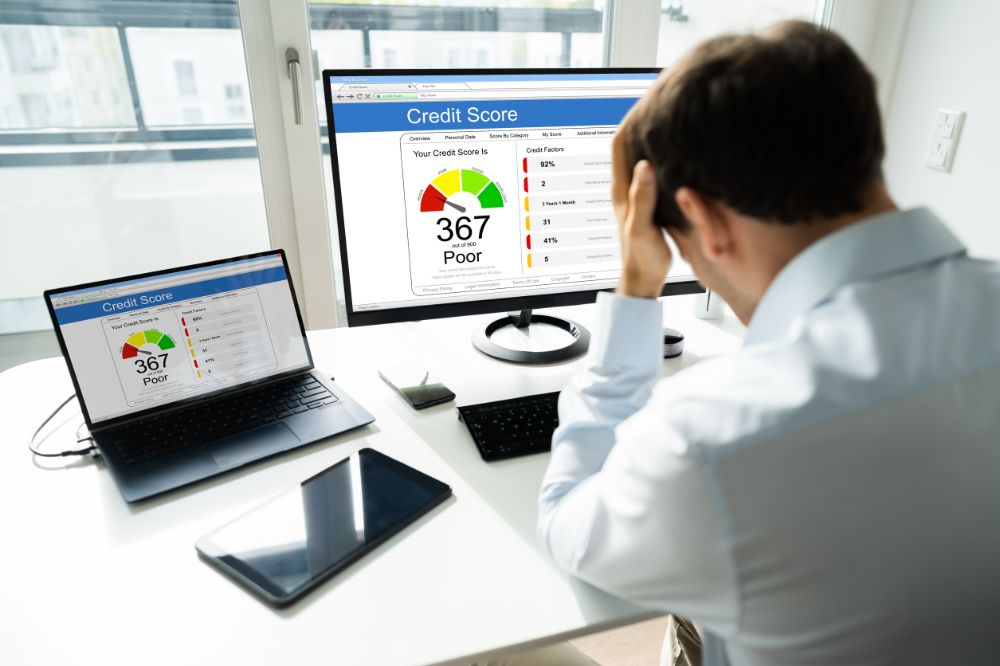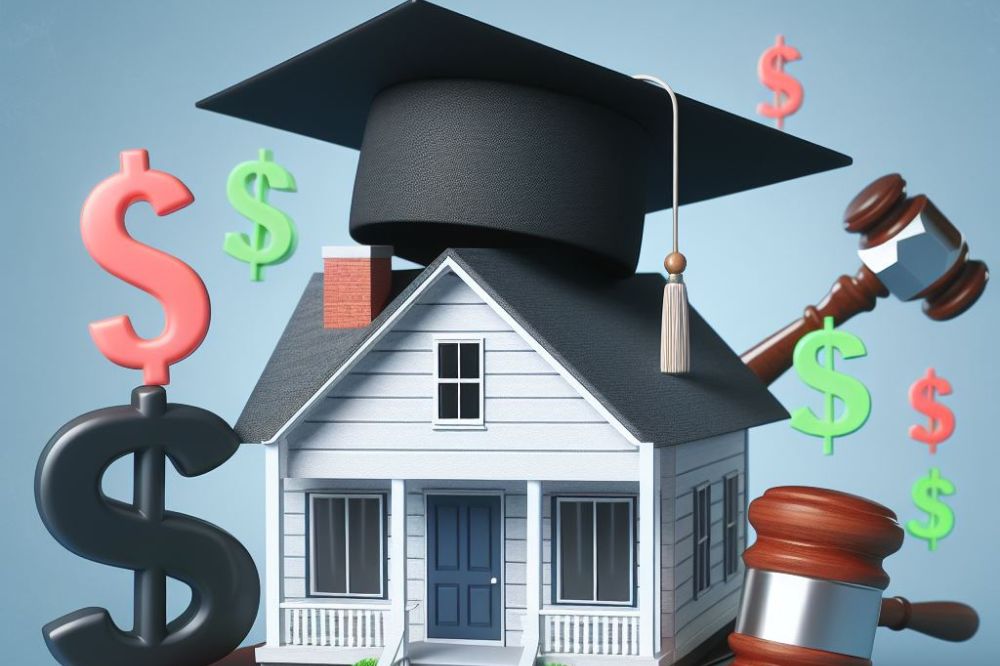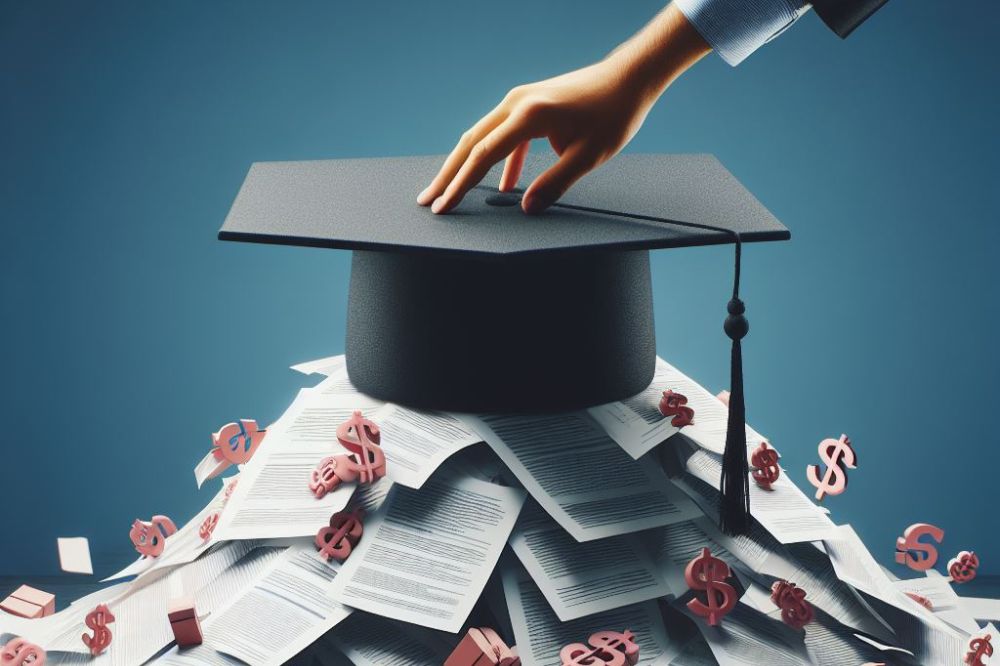Did you know that the vast majority of people, over 44 million Americans collectively owe around $1.7 trillion in student loan debt? Surprisingly, many individuals facing financial hardship turn to bankruptcy as a solution, hoping for student loan forgiveness. However, the relationship between bankruptcy and student loan forgiveness is complex and often misunderstood. Understanding how these two aspects, bankruptcy code and justice, intersect is crucial for those seeking relief from overwhelming debt burdens.
By exploring this nuanced relationship, you can gain valuable insights into navigating the challenging terrain of managing student loan debt amidst financial struggles.
Key Takeaways
- Bankruptcy and student loan forgiveness can be interconnected: Understanding the complexities of bankruptcy laws and student loan forgiveness can lead to potential solutions for those struggling with student debt.
- Awareness of the challenges: Recognizing the hurdles faced by individuals dealing with student loans and bankruptcy sheds light on the importance of exploring alternative pathways.
- Exploring new options: The emergence of new pathways signifies a changing landscape where individuals might find relief through innovative approaches to student loan repayment.
- Differentiating discharge and forgiveness: Understanding the distinctions between loan discharge and forgiveness can help individuals make informed decisions regarding their financial situations.
- Real-life examples provide insights: Case studies and scenarios offer practical insights into how bankruptcy and student loan forgiveness can impact individuals in various circumstances.
- Guidance in legal matters: Navigating the legal landscape surrounding student loans and bankruptcy requires informed decision-making and potentially seeking professional advice.
Understanding Bankruptcy
Basics Explained
Bankruptcy is a legal process that helps individuals or businesses eliminate or repay their debts under the Bankruptcy Code. It can provide a fresh financial start by clearing certain debts.
Student loan forgiveness is a program where borrowers are relieved of the obligation to repay some or all of their student loans, typically due to specific circumstances like working in public service.
The relationship between bankruptcy and student loan forgiveness lies in the fact that bankruptcy can potentially help with student loan debt relief. However, it’s crucial to understand the complexities and limitations surrounding this interaction.
Types in the US
In the US, there are different types of bankruptcy, including Chapter 7 (liquidation), Chapter 13 (repayment plan), and Chapter 11 (reorganization). Each type has specific eligibility criteria and implications for assets and debts.
When it comes to student loans, there are federal loans, private loans, and consolidation loans available. Federal loans offer various repayment plans and forgiveness options based on factors like income and employment.
Comparing bankruptcy types with student loans, Chapter 7 bankruptcy may discharge certain unsecured debts, while Chapter 13 involves creating a repayment plan. Similarly, federal student loans offer more flexibility compared to private loans.
Filing Process
The process of filing for bankruptcy involves gathering financial documents, completing credit counseling, submitting paperwork to the court, attending a meeting of creditors, and undergoing financial management education.
Applying for student loan forgiveness usually requires meeting specific criteria such as working in public service or qualifying for income-driven repayment plans. Borrowers need to submit applications along with supporting documentation.
While both processes involve paperwork and eligibility criteria, filing for bankruptcy is overseen by a court-appointed trustee, whereas applying for student loan forgiveness is typically done through the loan servicer or Department of Education.
Impact on Credit
Bankruptcy can significantly impact credit scores by causing them to drop by several hundred points. The record of bankruptcy stays on credit reports for up to ten years, affecting future borrowing opportunities.
On the other hand, student loan forgiveness generally does not have a direct negative impact on credit scores. However, if borrowers default on their loans before forgiveness occurs, it can lead to adverse effects on creditworthiness.
To rebuild credit after bankruptcy or student loan forgiveness, individuals can start by creating a budget, making timely payments on remaining debts, monitoring their credit reports regularly, and considering secured credit cards or small installment loans.

Student Loans in America
Types of Loans
Student loans come in two main forms: federal and private. Federal student loans are eligible for forgiveness through specific programs, while private student loans typically do not offer forgiveness options. When considering bankruptcy, it’s crucial to understand how each loan type interacts with the law.
Federal student loans have more flexible repayment options and forgiveness programs compared to private loans. Private student loans, on the other hand, often have higher interest rates and fewer borrower protections. In bankruptcy cases, federal student loans may be eligible for discharge under certain circumstances, while private loans are generally not dischargeable.
Repayment Plans
Several repayment plans cater to different financial situations, such as income-driven repayment plans and standard repayment plans. These plans dictate how much you pay monthly and for how long. When facing bankruptcy, the chosen repayment plan can influence the decision-making process.
Income-driven repayment plans tie monthly payments to your income level, making them more manageable during financial hardships. Standard repayment plans require fixed monthly payments over a set period. The choice of repayment plan should align with your financial capabilities and future goals when navigating potential bankruptcy scenarios.
Forgiveness Programs
Various forgiveness programs exist to help borrowers alleviate their student loan debt burden. Public Service Loan Forgiveness (PSLF) is one notable program that forgives federal student loans after working in public service for a specified period. Understanding the eligibility criteria for these programs is essential when exploring options for loan forgiveness.
Eligibility requirements for forgiveness programs often include factors like employment in specific sectors or making consistent payments for a set duration. It’s crucial to note any intersections between bankruptcy proceedings and eligibility for loan forgiveness programs to make informed decisions about managing student loan debt effectively.
The Challenge with Student Loans and Bankruptcy
Legal Standards
Declaring bankruptcy involves meeting specific legal criteria set by federal law. Individuals must demonstrate their inability to repay debts. Bankruptcy laws vary between Chapter 7 and Chapter 13, determining asset liquidation or repayment plans.
Proving undue hardship in student loan cases is a complex legal process. Courts require borrowers to show that continuing payments would cause extreme financial distress. This standard applies to both federal and private student loans.
The legal standards differ significantly between bankruptcy and student loan forgiveness. Bankruptcy focuses on overall financial circumstances, while student loan forgiveness specifically targets the burden of educational debt.
Proving Undue Hardship
Undue hardship in student loan cases typically involves meeting the Brunner Test criteria. This test evaluates three factors: poverty, persistence of financial situation, and good faith efforts to repay. Successful cases often showcase long-term financial struggles, such as disability or low income.
For instance, a borrower with a permanent disability preventing employment may qualify for undue hardship. Courts consider individual circumstances, like medical records and professional opinions, when assessing cases. These examples highlight the severity of financial challenges faced by borrowers.
However, proving undue hardship poses significant challenges in bankruptcy court. Courts often set high standards for demonstrating extreme financial difficulty, making it challenging for many borrowers to meet the criteria. The process requires thorough documentation and legal expertise to navigate successfully.
A New Pathway Emerges
Good but Slow Start
Navigating the realm of student loan forgiveness can be daunting, especially at the beginning. Initial challenges often include understanding complex regulations and gathering required documentation. Individuals may feel overwhelmed by the sheer volume of information needed.
Common obstacles arise during the bankruptcy process, such as lengthy paperwork and legal procedures. Patience is key as individuals embark on this journey towards financial relief. Encouragement is crucial to help them stay motivated amidst these initial hurdles.
Process Overview
The bankruptcy process involves declaring one’s inability to repay debts, leading to potential debt discharge or reorganization under court supervision. Filing for bankruptcy requires meticulous documentation and adherence to legal guidelines.
Applying for student loan forgiveness entails meeting specific criteria set by lenders or government programs. Steps involve completing forms, proving financial hardship, and awaiting approval. Key milestones include debt evaluation, repayment plan establishment, and final forgiveness confirmation.
Eligibility Criteria
To file for bankruptcy, individuals must meet certain criteria based on their financial situation and debt level. Eligibility requirements vary depending on the type of bankruptcy being pursued, such as Chapter 7 or Chapter 13.
Qualifying for student loan forgiveness typically involves demonstrating financial need or meeting specific employment conditions. Eligibility criteria may include working in public service or making consistent payments over a set period. Differences in eligibility criteria between bankruptcy and student loan forgiveness highlight the unique nature of each process.
Comparing Discharge vs. Forgiveness
Key Differences
Bankruptcy and student loan forgiveness differ significantly. Bankruptcy involves a legal process where debts are discharged, providing relief from financial obligations. In contrast, student loan forgiveness eliminates the need to repay all or part of the loan based on specific criteria.
Understanding these differences is crucial for informed decisions. Bankruptcy may impact credit scores and future borrowing ability, while student loan forgiveness offers relief without affecting credit ratings. The choice between them depends on individual circumstances and long-term financial goals.
Financial Implications
Filing for bankruptcy can have lasting financial implications. Bankruptcy stays on credit reports for up to ten years, affecting access to loans and increasing interest rates. On the other hand, student loan forgiveness can reduce or eliminate debt burdens, freeing up funds for other expenses.
After bankruptcy or loan forgiveness, managing finances becomes crucial. Post-bankruptcy, individuals must rebuild credit by making timely payments and practicing responsible financial habits. For those benefiting from student loan forgiveness, creating a budget that prioritizes savings and investments can ensure long-term financial stability.
Case Studies and Real-Life Scenarios
Successful Discharges
In real-life scenarios, successful bankruptcy discharges have been achieved by individuals facing overwhelming financial burdens. For instance, Sarah, a single mother struggling with medical debt and student loans, successfully had her debts discharged through bankruptcy. Her determination and the legal process allowed her to start fresh financially. Another inspiring case is Alex, a recent graduate burdened with high student loan debt due to unemployment. Through bankruptcy proceedings, his student loans were forgiven, providing him with a clean slate to rebuild his financial future.
Lessons Learned
From those who have navigated bankruptcy and student loan forgiveness processes, valuable lessons emerge. One key takeaway is the importance of seeking professional guidance and understanding the intricacies of these legal procedures. Many individuals emphasize the significance of meticulous documentation and transparency throughout the process. Moreover, learning from mistakes is crucial in achieving financial stability post-bankruptcy. Common missteps include failing to disclose all debts or assets accurately, which can impede the discharge or forgiveness process. It’s essential to be proactive in addressing financial challenges and seeking assistance when needed.
Navigating the Legal Landscape
Finding Legal Help
Finding reputable bankruptcy attorneys is crucial when dealing with financial challenges. Seek guidance from regional bar associations for trustworthy recommendations. Professional legal help is essential in understanding the complexities of bankruptcy and student loan forgiveness.
Resources for seeking legal assistance in student loan forgiveness cases can vary. Look for organizations specializing in student debt relief or consult with financial advisors. These professionals can provide valuable insights into navigating the legalities of loan forgiveness.
Professional legal assistance plays a vital role in navigating complex financial situations. Lawyers specializing in bankruptcy and student loan forgiveness can offer tailored advice based on individual circumstances. Their expertise ensures proper guidance through intricate legal processes.
Preparing Your Case
Prepare for bankruptcy proceedings by organizing all financial documents systematically. Ensure you have detailed records of income, expenses, debts, and assets to present to your attorney. Thorough preparation is key to a successful bankruptcy case.
When applying for student loan forgiveness, gather all necessary documentation such as proof of income, loan statements, and any correspondence with lenders. Be prepared to demonstrate your financial hardship and eligibility for forgiveness programs. Detailed documentation increases the chances of a successful application.
Thorough preparation is essential in both bankruptcy and loan forgiveness cases. By having all required documents ready and understanding the process thoroughly, you can expedite your case’s progress. Adequate preparation minimizes delays and increases the likelihood of a favorable outcome.

Future of Student Loans and Bankruptcy
Legislative Changes
Recent legislative changes have significantly impacted bankruptcy laws in the United States. One notable change is the difficulty in discharging student loans through bankruptcy. These changes have made it more challenging for individuals to seek financial relief through bankruptcy proceedings.
New regulations have also brought about changes in student loan forgiveness programs. These updates have introduced stricter criteria for eligibility, making it harder for borrowers to qualify for forgiveness. As a result, individuals facing overwhelming student loan debt may find it increasingly difficult to alleviate their financial burden through forgiveness programs.
The implications of these legislative updates are profound for individuals seeking financial relief. Many individuals struggling with student loan debt may now face limited options when considering bankruptcy as a means of debt relief. The stricter regulations surrounding student loan forgiveness further compound the challenges faced by borrowers seeking relief from their debts.
Predictions and Trends
Future trends in bankruptcy filings are expected to reflect the evolving legal landscape. With the current restrictions on discharging student loans through bankruptcy, there may be an increase in alternative debt relief strategies sought by individuals facing financial hardship. These trends indicate a shift towards exploring non-traditional avenues for managing debt.
Potential changes in student loan forgiveness policies could further impact the relationship between bankruptcy and student loans. As legislative changes continue to shape the landscape of debt relief options, borrowers may need to adapt their financial strategies accordingly. Understanding these potential policy shifts is crucial for individuals navigating the complexities of student loan debt and bankruptcy.
Insights into how economic factors may influence debt relief options highlight the dynamic nature of financial decision-making. Economic conditions play a significant role in shaping policies related to student loans and bankruptcy, impacting the choices available to individuals seeking relief from overwhelming debt burdens. By staying informed about these trends, borrowers can better position themselves to address their financial challenges effectively.
Tips for Managing Student Debt
Budgeting Strategies
Creating a budget is crucial for individuals navigating the complex relationship between bankruptcy and student loan forgiveness. To start, track all expenses meticulously to understand spending habits. By setting clear financial goals, one can prioritize student loan payments effectively.
To manage student loan payments post-bankruptcy, consider income-driven repayment plans. These plans adjust monthly payments based on income, ensuring they remain affordable. Explore loan consolidation options to streamline payments and potentially reduce interest rates.
After bankruptcy or loan forgiveness, it’s essential to develop a comprehensive financial plan. Include emergency savings, retirement contributions, and debt repayment strategies in this plan. Seek guidance from financial advisors to ensure long-term financial stability.

Refinancing Options
Exploring refinancing options after bankruptcy can provide a fresh start for managing student loan debt. Research various lenders offering refinancing solutions tailored to individual needs. Compare interest rates, terms, and benefits before making a decision.
Refinancing can help lower monthly payments by securing a lower interest rate than the original loans. It also allows borrowers to combine multiple loans into one convenient payment. This simplifies the repayment process and potentially saves money over time.
When considering refinancing opportunities post-bankruptcy or loan forgiveness, timing is crucial. Wait until credit scores have improved post-bankruptcy before applying for refinancing. This increases the chances of qualifying for better rates and terms that benefit long-term financial health.
Closing Thoughts
You’ve delved into the intricate relationship between bankruptcy and student loan forgiveness, understanding the challenges and potential solutions. As you navigate the complexities of student debt and legal landscapes, remember that informed decisions are your most potent tool. Drawing from case studies and real-life scenarios, you can shape a strategy tailored to your circumstances, ensuring a brighter financial future. The evolving landscape of student loans and bankruptcy offers hope for those burdened by debt, signaling a shift towards more accessible pathways to financial freedom.
Take charge of your financial well-being by exploring the tips provided and staying abreast of changes in student loan policies. Your journey towards managing student debt effectively starts with knowledge and proactive steps. Embrace the possibilities that arise from understanding your options and rights in navigating the intersection of bankruptcy and student loans. Your financial empowerment awaits.
Frequently Asked Questions
What is the impact of bankruptcy on student loan forgiveness?
Bankruptcy can potentially lead to student loan forgiveness if certain conditions are met, but it’s a complex process. Understanding the relationship between bankruptcy and student loan forgiveness is crucial for those seeking relief from overwhelming debt.
How do discharge and forgiveness differ in relation to student loans during bankruptcy?
Discharge eliminates the obligation to repay debts, while forgiveness cancels the remaining balance after meeting specific requirements. Knowing the distinctions between discharge and forgiveness is essential when navigating the complexities of student loans in bankruptcy proceedings.
Can student loans be forgiven through bankruptcy in America?
While it’s challenging, it is possible under specific circumstances. Seeking legal guidance and understanding the nuances of bankruptcy laws concerning student loans are vital steps towards exploring potential avenues for debt relief.
Are there any success stories or case studies showcasing student loan forgiveness through bankruptcy?
Real-life scenarios can shed light on how individuals have successfully obtained student loan forgiveness within a bankruptcy context. Exploring case studies can provide valuable insights into strategies, challenges, and outcomes related to seeking relief from student loan debt through bankruptcy.
What are some practical tips for managing student debt before considering bankruptcy options?
Proactive measures like creating a budget, exploring repayment plans, seeking income-driven options, and staying informed about available resources can help manage student debt effectively. Prioritizing financial literacy and early intervention may prevent extreme measures like filing for bankruptcy due to overwhelming debt burdens.




